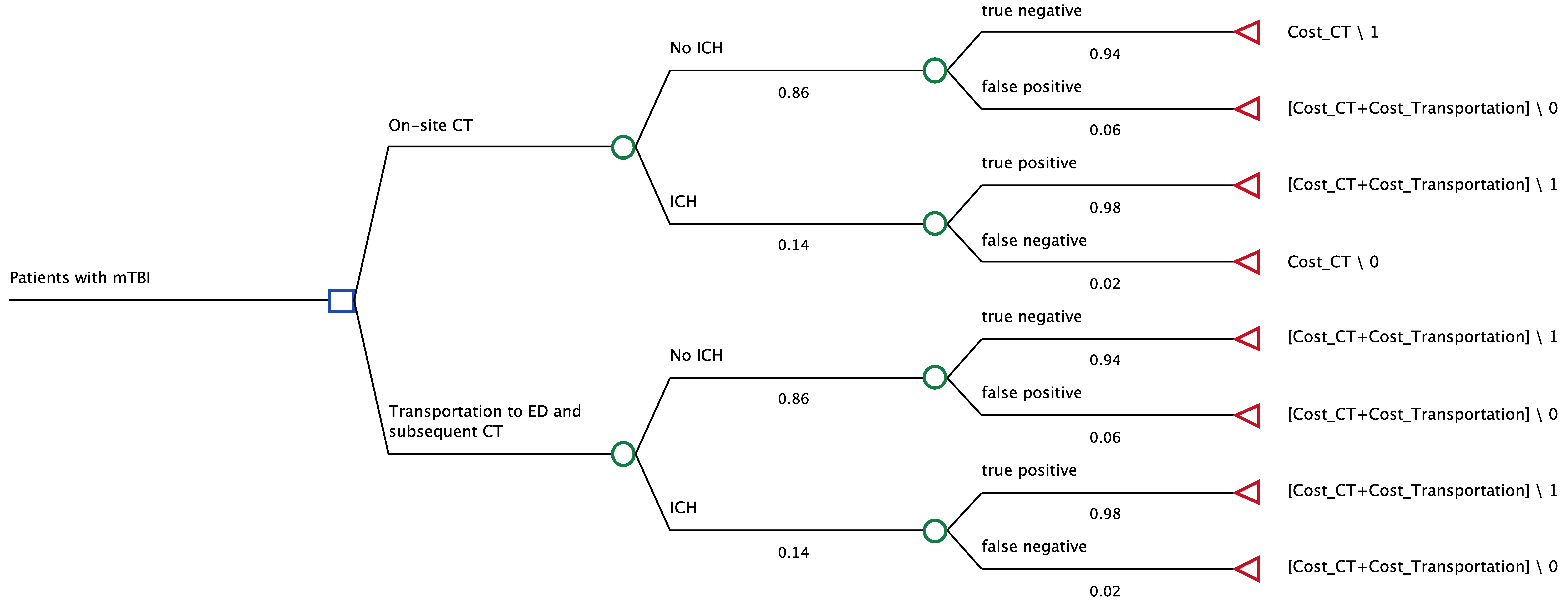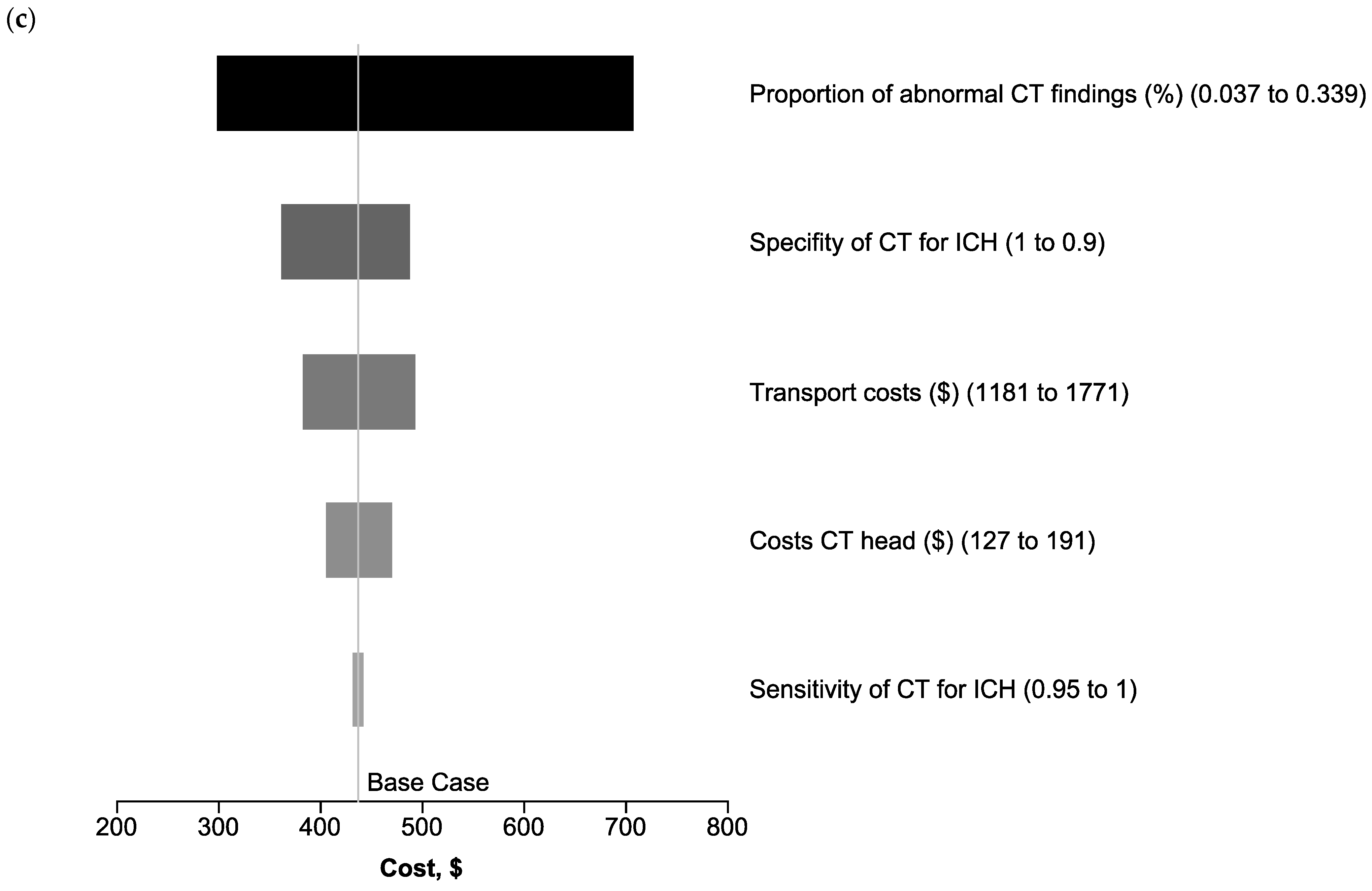Economic Evaluation of On-Site Computed Tomography at Major Events Using Data from the Munich Oktoberfest—A German and U.S. Healthcare Perspective
Abstract
1. Introduction
2. Methods
2.1. Study Population
2.2. Model Structure
2.3. Input Parameters
2.4. Outcomes
2.5. Sensitivity Analysis
2.6. Imaging
3. Results
Sensitivity Analysis Results
4. Discussion
Limitations
5. Conclusions
Author Contributions
Funding
Institutional Review Board Statement
Informed Consent Statement
Data Availability Statement
Conflicts of Interest
References
- Eymold, U. Oktoberfest. Historisches Lexikon Bayerns. 2013. Available online: https://www.historisches-lexikon-bayerns.de/Lexikon/Oktoberfest (accessed on 18 November 2024).
- Ghada, W.; Estrella, N.; Pfoerringer, D.; Kanz, K.-G.; Bogner-Flatz, V.; Ankerst, D.P.; Menzel, A. Effects of weather, air pollution and Oktoberfest on ambulance-transported emergency department admissions in Munich, Germany. Sci. Total. Environ. 2021, 755, 143772. [Google Scholar] [CrossRef] [PubMed]
- Rank, M. Wiesn-Ambulanz Zieht Bilanz: Weniger Einsätze Und Patienten—Das War Der höchste Gemessene Promillewert. Münchner Merkur. Available online: https://www.merkur.de/lokales/muenchen/oktoberfest/promille-wiesn-ambulanz-zieht-bilanz-weniger-einsaetze-patienten-jugendliche-betrunken-93340807.html (accessed on 7 October 2024).
- Aicher Ambulanz Union. 2025. Available online: https://aicher-ambulanz.de/pressemitteilung-wiesn-2023-2/ (accessed on 23 March 2025).
- Jagoda, A.S.; Bazarian, J.J., Jr.; Bruns, J.J., Jr.; Cantrill, S.V.; Gean, A.D.; Howard, P.K.; Ghajar, J.; Riggio, S.; Wright, D.W.; Wears, R.L.; et al. Clinical policy: Neuroimaging and decisionmaking in adult mild traumatic brain injury in the acute setting. Ann. Emerg. Med. 2008, 52, 714–748. [Google Scholar] [CrossRef] [PubMed]
- Jagoda, A.S.; Cantrill, S.V.; Wears, R.L.; Valadka, A.; Gallagher, E.; Gottesfeld, S.H.; Pietrzak, M.P.; Bolden, J.; Bruns, J.J.; Zimmerman, R. Clinical policy: Neuroimaging and decisionmaking in adult mild traumatic brain injury in the acute setting. Ann. Emerg. Med. 2002, 40, 231–249. [Google Scholar] [CrossRef] [PubMed]
- Flatz, W.; Hinzmann, D.; Kampmann, P.; Poehlmann, L.; Reidler, P.; Schlichtiger, J.; Kanz, K.-G.; Ricke, J.; Bazarian, J.; Bogner-Flatz, V. Mobile Computed Tomography at Munich Oktoberfest. N. Engl. J. Med. 2023, 389, 1051–1052. [Google Scholar] [CrossRef] [PubMed]
- Landeshauptstadt München RfAuW. Auf Geht’s zur Wiesn 2024—Alle Neuerungen auf dem Oktoberfest auf einem Blick. Available online: https://www.oktoberfest.de/informationen/oktoberfest-news/auf-gehts-zur-wiesn-2024-alle-wichtigen-neurungen (accessed on 20 November 2024).
- Flatz, W.; Reidler, P.; Kampmann, P.; Kanz, K.-G.; Ricke, J.; Bazarian, J.J.; Hinzmann, D.; Bogner-Flatz, V. Mobile computed tomography at the Munich Oktoberfest: From idea to implementation. Radiologie 2024, 64, 16–23. [Google Scholar] [CrossRef] [PubMed]
- Biberthaler, P.; Kanz, K.G.; Leidel, B.A. Emergency department management of mild traumatic brain injury in adults—An evidence-based algorithmic approach. MMW Fortschr. Med. 2016, 158, 53–56. [Google Scholar] [CrossRef] [PubMed]
- Yun, T.J.; Choi, J.W.; Han, M.; Jung, W.S.; Choi, S.H.; Yoo, R.-E.; Hwang, I.P. Deep learning based automatic detection algorithm for acute intracranial haemorrhage: A pivotal randomized clinical trial. NPJ Digit. Med. 2023, 6, 61. [Google Scholar] [CrossRef] [PubMed]
- Kassenärztliche_Bundesvereinigung_KdöR_(KBV). Einheitlicher Bewertungsmaßstab (EBM): 4. Quartal 2024; National Association of Statutory Health Insurance Physicians: Berlin, Germany, 2024. [Google Scholar]
- Zentrale_Abrechnungsstelle_für_den_Rettungsdienst_Bayern_GmbH_(ZAST). Kosten des Rettungsdienstes; Zentrale Abrechnungsstelle für den Rettungsdienst Bayern GmbH: Munich, Germany, 2024. [Google Scholar]
- Medicare.gov. Procedure Price Lookup. Available online: https://www.medicare.gov/procedure-price-lookup/ (accessed on 21 November 2024).
- Centers_for_Medicare_&_Medicaid_Services. Ambulance Fee Schedule Public Use Files. Available online: https://www.cms.gov/medicare/payment/fee-schedules/ambulance/ambulance-fee-schedule-public-use-files (accessed on 2 December 2024).
- Kassenarztliche Bundesvereinigung. Einheitlicher Bewertungsmaßstab. KBV. Available online: https://ebm.kbv.de/index.xhtml (accessed on 2 December 2024).
- Centers for Medicare & Medicaid Services. Physician Fee Schedule. CMS. Available online: https://www.cms.gov/medicare/physician-fee-schedule/search?Y=0&T=0&HT=0&CT=2&H1=70450&C=100&M=5 (accessed on 2 December 2024).
- Zentrale Abrechnungsstelle fur den Rettungsdienst Bayern GmbH. ZAST Onlineportal. ZAST. Available online: https://www.zastportal.de/zast/ (accessed on 2 December 2024).
- Yang, L.J.; Lassarén, P.; Londi, F.; Palazzo, L.; Fletcher-Sandersjöö, A.; Ängeby, K.; Thelin, E.P.; Wahlin, R.R. Risk factors for traumatic intracranial hemorrhage in mild traumatic brain injury patients at the emergency department: A systematic review and meta-analysis. Scand. J. Trauma Resusc. Emerg. Med. 2024, 32, 91. [Google Scholar] [CrossRef] [PubMed]
- Wolin, J.; Friedman, M.S. EMS Mass Gatherings; StatPearls: Tampa, FL, USA, 2024. [Google Scholar]
- Spaepen, K.; Cardinas, R.; Haenen, W.A.P.; Kaufman, L.; Hubloue, I. The Impact of In-Event Health Services at Europe’s Largest Electronic Dance Music Festival on Ems and Ed in the Host Community. Int. J. Environ. Res. Public Health 2023, 20, 3207. [Google Scholar] [CrossRef] [PubMed]
- McQueen, C.; Davies, C. Health care in a unique setting: Applying emergency medicine at music festivals. Open Access Emerg. Med. 2012, 4, 69–73. [Google Scholar] [CrossRef] [PubMed][Green Version]
- Grange, J.T.; Baumann, G.W.; Vaezazizi, R. On-site physicians reduce ambulance transports at mass gatherings. Prehospital Emerg. Care 2003, 7, 322–326. [Google Scholar] [CrossRef] [PubMed]
- Ranse, J.; Hutton, A.; Keene, T.; Lenson, S.; Luther, M.; Bost, N.; Johnston, A.N.B.; Crilly, J.; Cannon, M.; Jones, N.; et al. Health Service Impact from Mass Gatherings: A Systematic Literature Review. Prehospital Disaster Med. 2017, 32, 71–77. [Google Scholar] [CrossRef] [PubMed]
- Bennett, J.F.; Cottrell, D.J. Glastonbury Festival: Medical Care at the World’s Largest Greenfield Music Festival. Prehospital Disaster Med. 2024, 39, 170–177. [Google Scholar] [CrossRef] [PubMed]
- Prager, R.; Sedgwick, C.; Lund, A.; Kim, D.; Ho, B.; Stachura, M.; Gutman, S. Prospective Evaluation of Point-of-Care Ultrasound at a Remote, Multi-Day Music Festival. Prehospital Disaster Med. 2018, 33, 484–489. [Google Scholar] [CrossRef] [PubMed]
- Turris, S.A.; Callaghan, C.W.; Rabb, H.; Munn, M.B.; Lund, A. On the Way Out: An Analysis of Patient Transfers from Four Large-Scale North American Music Festivals Over Two Years. Prehospital Disaster Med. 2019, 34, 72–81. [Google Scholar] [CrossRef] [PubMed]



| Study Population | ||
| Patients (total) | 498 | |
| Patients being transported to the ED | 69 (14%) | |
| -with abnormal CT findings | 52 (11%) | |
| -because of challenging clinical management | 17 (3%) | |
| CT scan | ||
| Sensitivity ICH | 0.98 [11] | |
| Specificity ICH | 0.94 [11] | |
| Reimbursement rate for CT scanning (Germany) | 88.31 € [16] | https://www.kbv.de/html/ebm.php, accessed on 9 December 2024. |
| Reimbursement rate for CT scanning international patients (Germany) | 159 € | |
| CT scan head (CPT Code 70450) | $104 [17] | |
| Transportation | ||
| Reimbursement rate for ALS 1 emergency ambulatory transport (Germany) | 820 € [18] | |
| Reimbursement rate for ALS 1 emergency ambulatory transport of international patients (Germany) | 1476 € | |
| Average distance to the ED (miles) | 3 | |
| Ground distance per statute mile (CPT Code A0425) | $8.76 [15] | |
| ALS1 emergency, advanced life support, ambulance emergency transport (CPT Code A0427) | $272.44 [15] |
| Scenario | Costs of On-Site CT | Costs of Primary Transport to ER | Difference |
|---|---|---|---|
| Germany | EUR 243 | EUR 908 | EUR 665 |
| International patient | EUR 438 | EUR 1635 | EUR 1197 |
| U.S. perspective (Rochester) | USD 160 | USD 403 | USD 242 |
| Scenario | Costs of On-Site CT | Costs of Primary Transport to ER | Difference |
|---|---|---|---|
| Germany | EUR 220 | EUR 908 | USD 688 |
| International Patient | EUR 385 | EUR 1564 | EUR 1179 |
| U.S. perspective (Rochester) | USD 152 | USD 403 | USD 251 |
Disclaimer/Publisher’s Note: The statements, opinions and data contained in all publications are solely those of the individual author(s) and contributor(s) and not of MDPI and/or the editor(s). MDPI and/or the editor(s) disclaim responsibility for any injury to people or property resulting from any ideas, methods, instructions or products referred to in the content. |
© 2025 by the authors. Licensee MDPI, Basel, Switzerland. This article is an open access article distributed under the terms and conditions of the Creative Commons Attribution (CC BY) license (https://creativecommons.org/licenses/by/4.0/).
Share and Cite
Flatz, W.; Bogner-Flatz, V.; Hinzmann, D.; Jeffrey, B.J.; Ricke, J.; Karl-Georg, K.; Kunz, W.G.; Mehrens, D. Economic Evaluation of On-Site Computed Tomography at Major Events Using Data from the Munich Oktoberfest—A German and U.S. Healthcare Perspective. J. Clin. Med. 2025, 14, 2375. https://doi.org/10.3390/jcm14072375
Flatz W, Bogner-Flatz V, Hinzmann D, Jeffrey BJ, Ricke J, Karl-Georg K, Kunz WG, Mehrens D. Economic Evaluation of On-Site Computed Tomography at Major Events Using Data from the Munich Oktoberfest—A German and U.S. Healthcare Perspective. Journal of Clinical Medicine. 2025; 14(7):2375. https://doi.org/10.3390/jcm14072375
Chicago/Turabian StyleFlatz, Wilhelm, Viktoria Bogner-Flatz, Dominik Hinzmann, Bazarian J. Jeffrey, Jens Ricke, Kanz Karl-Georg, Wolfgang G. Kunz, and Dirk Mehrens. 2025. "Economic Evaluation of On-Site Computed Tomography at Major Events Using Data from the Munich Oktoberfest—A German and U.S. Healthcare Perspective" Journal of Clinical Medicine 14, no. 7: 2375. https://doi.org/10.3390/jcm14072375
APA StyleFlatz, W., Bogner-Flatz, V., Hinzmann, D., Jeffrey, B. J., Ricke, J., Karl-Georg, K., Kunz, W. G., & Mehrens, D. (2025). Economic Evaluation of On-Site Computed Tomography at Major Events Using Data from the Munich Oktoberfest—A German and U.S. Healthcare Perspective. Journal of Clinical Medicine, 14(7), 2375. https://doi.org/10.3390/jcm14072375








